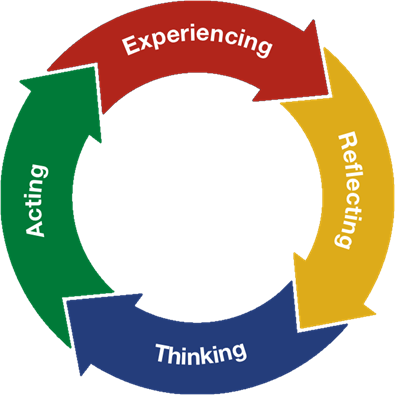EXPERIENTIAL LEARNING
Experiential learning is
a constructivist and heuristic way to help people identify changes necessary to
their skills, attitudes and behaviours, then implement the changes for better
performance.
Experiential learning
(EL) is may be simply explained: learning by doing.
Everyone has learned to
walk or talk, not by being shown or told, but by practising and improving as
time passed. Consequently, this method can be implemented in all sorts of
situations with people from all walks of life. EL can be applied
regardless age, education, experience, ability, background or culture
Within the field of
Talent Development, EL can best be defined as:“developing personal
understanding, knowledge, skills and attitudes through the analysis of, and
reflection on, activity”.
In this definition
‘Activity’ is used as being anything from an individual explaining an idea or
completing a simple task to highly complex group interactions involving a wide
range of mental attributes and behaviours.
One of the quickest ways
to highlight the ways in which experiential learning differs from other
methodologies is to take a look at what it is not:
In order to understand
better the differences between EL and all the other methodologies you should
pay attention to the following features:
1. EL
is not the writing of new information onto the blank slate of your mind.
- Nor is it the act of memorising a
rigid bank of knowledge.
- EL is not a passive process that
happens to a learner; rather it is an active process that engages them and
invites participation.
Experiential learning
stands in contrast to well-known theories of learning such as behaviouralism
and implicit learning. EL brings a different theoretical perspective. EL focuses
on the learning process rather than outcomes
Behavioural conceptualisations
of learning suggest you can measure effectiveness of learning by the number of
facts or habits a person has learned in response to stimulus questions or
conditions. These elements of thought – or ideas – are fixed, and the goal is
acquiring more of them.
EL suggests that ideas
are not fixed; rather, they form and re-form through experience. Experience
intervenes and because this is unique each time, so too are the resulting
ideas. In EL, the measure of success therefore moves beyond acquisition of
facts, and instead becomes lasting behavioural change, the development of
skills and behaviours to respond to different situations, and an ability to
apply this knowledge.
Learning is therefore an
emergent process with the learner at the centre of the process: learning is
based on where the participant is, their relationship with what has happened
previously, and where they want to be in the future. It’s easy to see the
appeal when compared to other theoretical approaches which define a rigid
outcome and focus on making the learner reach it. The process of learning is
grounded in experience. Implementing, testing, evaluating and refining ideas
exclusively with reference to familiar experiences does not present an
opportunity for learning, because experience must defy expectation to hold
value.
........
So, how can we structure
an experience in a way that makes experiential learning possible?
First let’s take a look
at the abilities a learner needs when having an experiential learning task:
1
Concrete experience
2
Reflective observation
3
Abstract conceptualisation
4
Active experimentation
1.
Concrete experience (CE)
Concrete experience
abilities are those which allow a learner to engage openly in experiences.
Without these, their interpretation risks being limited and skewed by bias.
2.
Reflective observation (RO)
Reflecting on an activity
and its outcomes is a vital part of learning, and a learner needs to be able to
reflect from multiple perspectives. Someone working through the first half of
an individual review sheet to crystallise their understanding of an activity is
engaging in reflective observation.
3.
Abstract conceptualisation (AC)
These abilities allow
learners to integrate their observations and reflections into new theories,
which act as the basis for the next set of abilities. Group discussion and
completion of the second half of the individual review sheet allows a
participant to form abstract conceptualisations about an activity.
4.
Active experimentation (AE)
Through AE, learners test
the theories arrived at through the previous abilities. With these four
abilities working in tandem, learners develop their understanding. Repeating
the activity based on the insights
gained in the previous steps forms the active experimentation stage.
Experiential learning is
made possible in situations in which each of these abilities is given the space
to work. New experiences are presented with which learners can engage, then
facilitation allows for observations to be discussed and new conceptualisations
to be formed. The cycle is then repeated, giving learners an opportunity to
test their new theories and build their understanding.
Depending on the nature
of an experience, the area of knowledge that contains it, and various other
factors, the relationship between these abilities will be different.
Jean Piaget: 1896-1980
Piaget conceived
experience, conceptualisation, reflection, and action as the basis for adult
thought.
He believed that as we
grow, we view the world in an abstract way and can construct our own meaning
and knowledge as a result. This differs from children who have a concrete
phenomenological interpretation.
Thus learning requires
interaction between an individual and their environment. Concepts and schemas
are assimilated from and accommodate to experiences, and if either of these
things becomes dominant, learning is interrupted:
-
Too much accommodation and we imitate
things and sculpt ourselves to our environment rather than learning from it.
-
Too much assimilation and we end up
imposing ourselves with no regard for environmental realities.
As adults we are able to
manipulate the balance of these two factors to make efficient learning more
possible. In experiential learning this is achieved by tailoring the nature of
the activity and providing suitable facilitation.
The experiential learning cycle
David Kolb drew inspiration from these ideas and distilled them down into the Experiential Learning Cycle, represented by the diagram below:
Bibliography
What
is Experiential Learning? https://www.experientiallearning.org/info/what-is-experiential-learning


Comentarii
Trimiteți un comentariu